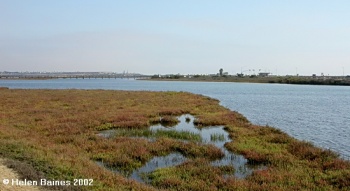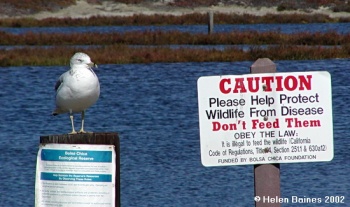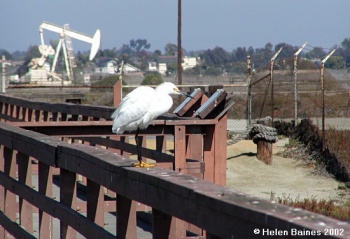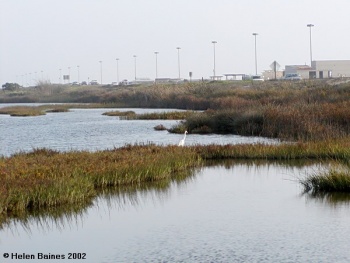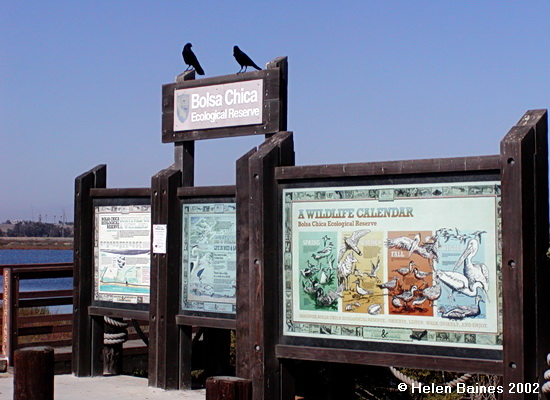
Information board at south entrance to Bolsa Chica Ecological Reserve, Orange County, California, USA
Overview
The Bolsa Chica Ecological Reserve is located on the coast in western Orange County, California, USA, in the city of Huntington Beach and is separated from the Bolsa Chica State Beach by the Pacific Coast Highway. It is part of the State Ecological Reserves system, managed by the California Department of Fish and Game, and its purpose is to protect the estuarine tidal saltwater marsh habitat, with its resident, threatened and endangered species. The Reserve is a remnant of an ancient coastal wetland, originally 4000 acres in size. The area was once part of the Nieto land grant, and on Nieto's death, his son inherited 8000 acres, 4000 acres of which were coastal wetland. He named this property Rancho La Bolsa Chica, because the bigger lagoon looked like a small purse or pocket - "bolsa chica" meaning small purse in Spanish.
Bolsa Chica is a major stop-over for migratory birds using the Pacific Fly-Way. Over 200 species can be seen at the Bolsa Chica during the year. Many are resident and some are migrants which nest there. Other plant and animal species found in California coastal wetlands can also be seen.
Birds
Notable Species
- Belding's Savannah Sparrow (Passerculus sandwichensis beldingi), a State Listed Endangered Species which lives and nests only in pickleweed.
- Light-footed Ridgway's Rail (Railus obsoletus levipes), a State and Federal endangered species which nests only in cordgrass marshes.
- California Least Tern (Sterna antillarum browni), a State and Federal endangered species - 10% of the world's population is found here.
- Western Snowy Plover (Charadrius alexandrinus nivosus), a Federal Threatened Species, which nests in only a few coastal areas of California.
- Black Skimmer (Rhynchops niger).
- American Avocet (Recurvirostra americana)
- Reddish Egret (Egretta rufescens) Recently extending its range north from Baja California, has been seen year round at Bolsa Chica for the at least the last two years.
Rarities
Elegant Tern (Sterna elegans). Has bred at Bolsa Chica since 1987.
Check-list
Birds you can see here include:
American White Pelican, Brown Pelican, Northern Harrier, White-tailed Kite, Red-shouldered Hawk, Osprey, American Kestrel, Black Phoebe, Common Yellowthroat, Savannah Sparrow, Western Meadowlark
Other Wildlife
Animal list as PDF3, see below in External Links.
Site Information
History and Use
Bolsa Chica is presently about 1550 acres in size and consists of undeveloped coastal wetland and adjacent upland areas, but it was once part of a 165,000 acre Spanish land grant. Native Americans once lived here, finding shellfish and other food stuffs in the wetlands, and making their home on the upland mesas.
In 1900, the natural ocean inlet was closed, supposedly to improve duck hunting, and this destroyed the tidal nature of the wetland. During the next 70 years, the area was used for farming, raising crops such as potatoes, and also for the grazing of cattle and sheep. Oil was discovered in 1920 and Standard Oil leased the land for drilling. The lease was later taken over by Signal Oil. Coastal artillery mounts and bunkers were built during WWII. Then in 1970, Signal Oil bought the land for development. In 1972 the Coastal Act became law. In 1973 the State of California received about 300 acres of wetlands next to the Pacific Coast Highway in a controversial land swap, and in 1979 the Bolsa Chica Ecological Reserve was developed from a portion of the 300 acres, the rest remaining privately owned. The organization, Amigos de Bolsa Chica, had been formed in 1976 to protect the wetlands and in 1989 they were successful in reducing the plan to build a huge marina, with residential and commercial development.
In 1997, the State bought 880 acres of Bolsa Chica wetlands from Signal Oil and more acres were acquired over the next few years. By 2000, about 1200 acres were publically owned, and in 2001, planning began to restore 550 acres of the historic Bolsa Chica lowlands.
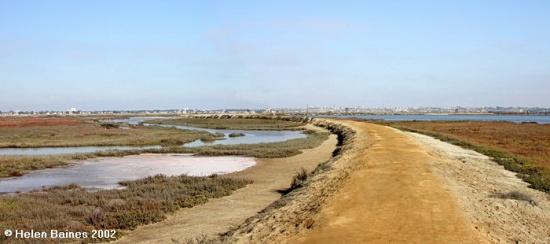
Looking north on the Loop Trail at Bolsa Chica Ecological Reserve, Orange County, California, USA. N.B. this photo was taken in 2002 before the restoration project to reopen the tidal inlet was started, so the landscape has probably changed somewhat.
In 2004, restoration of nearly 600 acres began so that the area would become tidal again, and in August 2006, the new tidal inlet was finally opened allowing seawater to flow into the wetlands for the first time in over 100 years. Photos on the Amigos website: [1]. Opening of inlet, see the online newsletter at: [2].
The Amigos de Bolsa Chica have spent over 30 years working to acquire, preserve and restore the wetlands. Restoration project websites: [3] [4]
Areas of Interest
The Restoration Project begun in 2004 and finished in 2006, involved the construction of a $100 million bridge to carry the Pacific Coast Highway over a newly opened inlet from the Pacific Ocean. For the first time in 100 years, fresh ocean waters were able to enter the wetlands at Bolsa Chica. It is hoped that this will restore and refresh the habitat in this important Pacific coast stop-over on the fly-way for migratory birds. The project was financed by the ports of Long Beach and Los Angeles, in trade for acquisition and expansion of additional coastal land for port use. [5]
Access and Facilities
Directions: From the north, exit the San Diego Freeway (405) at Seal Beach Boulevard and go west towards the beach. Turn left on Pacific Coast Highway and continue south past the Warner Avenue intersection. At the next stoplight, turn left into the Bolsa Chica Ecological Reserve south parking lot, about 1 mile south of Warner Avenue.
Traveling from the south toward Huntington Beach on San Diego Freeway (405), exit Golden West Street. Drive west to Pacific Coast Highway, turning right where Golden West ends. Continue north and at the second stoplight, turn right into the Reserve parking lot. If you get to Warner Avenue, you have gone too far, but you can turn right here and visit the Interpretive Center (3842 Warner Avenue), before turning around and back tracking, about 1 mile, to the south parking lot.
The Bolsa Chica Ecological Reserve boundaries are Warner Avenue to the north, Seapoint Avenue to the south, Pacific Coast Highway to the west, and residential development to the east.
For an Area Map4 see below in External Links.
There are two small parking lots. The Bolsa Chica Interpretive Center can be accessed from the north lot southeast of the intersection of Warner & Pacific Coast Highway. It is the starting point for the Mesa Trail, which leads to the overlook and rest stop at Mesa Point. The south lot on Pacific Coast Highway across from the entrance to Bolsa Chica State Beach, is the starting point for the 1.5 mile Loop Trail, which crosses a wooden bridge, passes two overlooks, and returns to the parking lot via a sand-dune trail paralleling Pacific Coast Highway.
The Reserve is open during daylight hours, 365 days a year. Parking and entrance are free.
The Interpretive Center on Warner Avenue is open as follows:
Tuesday-Friday 10am - 4pm
Saturday 9am - noon
Sunday 12:30pm - 3:30pm
Hiking, birdwatching and photography are popular activities at the Reserve.
For special rules to protect the wildlife at Bolsa Chica, please see page 3 of their newsletter online at:
Free public tours are offered at Bolsa Chica and leave from the south parking lot. The first Saturday of each month, between 9 - 10:30am, tours conducted by the docents of the Amigos de Bolsa Chica, will leave every 15 minutes.
For details of other tours available, see the Amigos website here: [6]
The third Sunday of each month at 10am a tour is conducted by the Bolsa Chica Land Trust. For more information, call 714-964-8170 or check on the website: [7]
Contact Details
General Information
Bolsa Chica Conservancy and Interpretive Center
3842 Warner Avenue
Huntington Beach, CA 92649-4263
Phone: (714) 846-1114
Fax: (714) 846-4065
Tours and Hike Information
info@bolsachica.org
Amigos de Bolsa Chica
P.O Box 1563
Huntington Beach, CA 92647
Phone/Fax (714) 840-1575
Email: info@amigosdebolsachica.org
Website: [8]
Bolsa Chica Land Trust
5200 Warner Avenue #108,
Huntington Beach, CA 92649
(714) 846-1001
Office hours 10am-3pm, Monday-Friday
Contact us at: bclt@bolsachicalandtrust.org
External Links
- Bolsa Chica Conservancy
- Amigos de Bolsa Chica
- Bolsa Chica Land Trust
- California FWS website
- Bolsa Chica on Google Maps
Content and images posted by HelenB
Reviews
raulroa's review:
This location is very accessible and close to the freeways. Parking is at two locations on the north end and south end and the nature center has free information about the trail and what can be seen while walking. There are many areas that are super close to water and many birds just hang out close for photo ops. Although some of the area is closed for construction, it is still real good for birding and when the reconstruction is completed, there will be even better opportunities to see birds upclose.
Pros
- Excellent proximity to freeway and right on Pacific Coast Highway; long trails and lots of birds; there is a nature center that has free trail guide; there is a small bridge where birds came very close and easily photographed
Cons
- Some of the area is being removated so it is closed during construction but there is plenty of trail to travel and many birds all of the time; too much trash at the north end and at a point where a canal comes in.
DiggitalD's review:
Bolsa Chica is a great spot to catch migratory birds during the winter. White & brown pelicans share water with all kinds of wading, swimming, and diving birds. There are several types of heron and egret which are predictable. There are also plenty land-oriented birds like phoebes, meadowlarks, etc.. Harriers show up like clockwork, along with red-shoulders, ospreys, kites, kestrels, and sometimes other falcons. It's a nice, open area.
Pros
- wide variety of birds
Cons
- pollution and limited access
Lorax Dan's review:
Pros
- Fantastic for viewing a variety of birds.
Cons
- Close to noisy highway and industrial spoiling
droll13's review:
Just an update:
On August 24, 2006, a sand barrier was removed, and the wetlands were reunited with the Pacific Ocean for the first time in more than 100 years. This was a milestone in a long-running restoration project.
There are reports that the inflow of ocean water has changed some of the local conditions so you might have to explore a bit to find your favorite birds' new 'homes' in the wetlands. For example, shallow water feeders (ducks and other diving birds, herons and other waders), might find that their previous shallow feeding places (such as around the footbridge) are now deeper.
On the other hand, I'm hoping is that high tide will deepen the water enough so the Brown Pelicans can be seen more often from the footbridge executing their spectacular dives.
The wetlands remains a terrific, easily accessible location
Pros
- variety of fauna; convenient location
Cons
- trash in some areas; footbridge sometimes crowded with photographers






